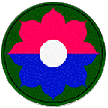 |
335th Radio Research Company Vietnam Campaigns |
 |
 |
335th Radio Research Company Vietnam Campaigns |
 |
 Updated: 5 September 1999
Updated: 5 September 1999
| Following the U.S. victory in the Ia Drang Valley, American forces for the remainder of 1965 and well into 1966 sought to keep the enemy off balance while building base camps and logistical installations. This involved search and destroy operations to protect the logistical bases under construction along the coast and the base camps for incoming U.S. units in the provinces near Saigon. Also of particular concern to the American military mission was the protection of the government and the people of South Vietnam. To accomplish the tasks outlined U.S. efforts were concentrated in the most vital and heavily populated regions. The III Marine Amphibious Force supported the South Vietnamese I Corps in the northern provinces; the I Field Force supported the Vietnamese II Corps in the central region; and the II Field Force supported the South Vietnamese III Corps around Saigon. Consequently, the major battles of the year occurred in these critical areas. The 1st Brigade, 101st Airborne Division, the Korean 2d Marine Brigade, and the ARVN 47th Regiment began Operation VAN BUREN on 19 January to locate and destroy the North Vietnamese 95th Regiment, which was believed to be in the Tuy Hoa Valley. Their mission included protecting the rice harvest produced in the coastal region. The successful execution of these assignments resulted in serious enemy losses. During 20-23 January, a temporary cease fire was proclaimed in honor of the lunar new year (Tet), although minor clashes continued throughout this period. During February and March, U.S. intelligence reported heavy North Vietnamese Army infiltration from Laos and across the demilitarized zone into Quang Tri Province. Only the South Vietnamese 1st Division and a single U.S. marine battalion were deployed to the province. However, to defend against this threatened invasion the bulk of the U.S. 3d Marine Division and the first U.S. Army combat units, the 173d Airborne Brigade, were moved into the northern provinces. On April 12, U.S. B-52s based on Guam bombed infiltration routes near the Laos border in the first use of these weapons against NVA. Throughout this phase of the campaign, the enemy continued to take refuge in Laos, Cambodia, and North Vietnam. Driving the enemy back removed the threat of harassment of the populace by North Vietnamese regular forces and curbed local guerrilla activity. |